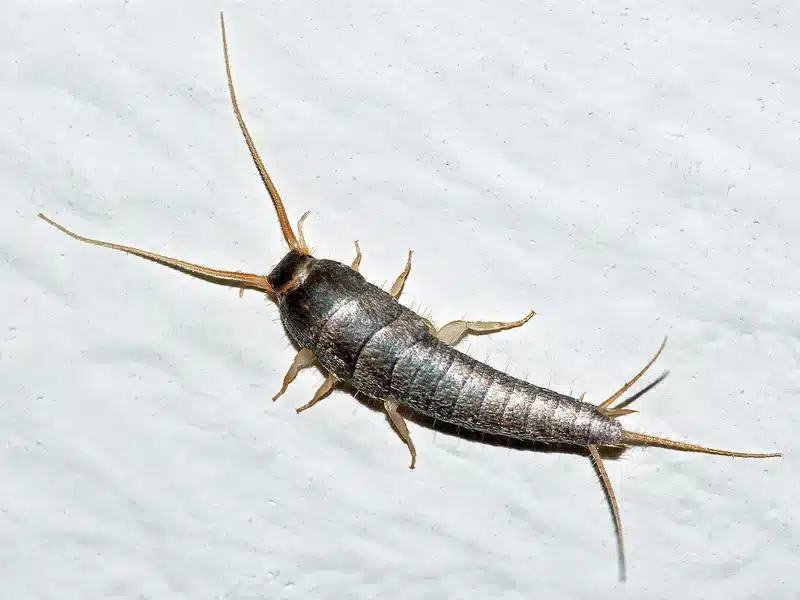If you’ve ever spotted tiny white specks moving across your basement floor or bathroom baseboards, you might be looking at silverfish larvae. These cream-colored insects are often the first sign of what could become a major household pest problem.
In my four years as a registered technician, I’ve seen how catching these pests early makes all the difference. Our family business has been serving homes across Virginia, Maryland, and DC for over 50 years. During that time, we’ve learned that early identification and quick action can prevent silverfish larvae from turning into a full-scale infestation that’s much harder to control.
What Are Silverfish Larvae? Understanding the Silverfish Life Cycle
Silverfish larvae are actually the early nymphal stages of silverfish development. These wingless insects belong to the order Zygentoma and include four main species found in North American homes. The most common is the small blue silverfish (Lepisma saccharinum), but you might also encounter gray silverfish, four-lined silverfish, or heat-loving firebrats.
Unlike many insects, silverfish don’t go through complete metamorphosis. Instead, they develop through a series of nymphal stages that look like tiny versions of adults. This process is called ametabolous development, basically meaning the young look similar to adults from the start.
The complete life cycle goes from egg to multiple nymphal instars (the “larvae” stage) to sexually mature adults. What’s particularly challenging is that adults can live 6-8 years and continue molting throughout their entire lives.
Identifying Silverfish Larvae
First instar silverfish larvae are pale cream-white and translucent, measuring only 2-3 mm long. They lack the characteristic silver scales that give adult silverfish their name. You’ll notice they have proportionally large heads and short antennae compared to their body size.
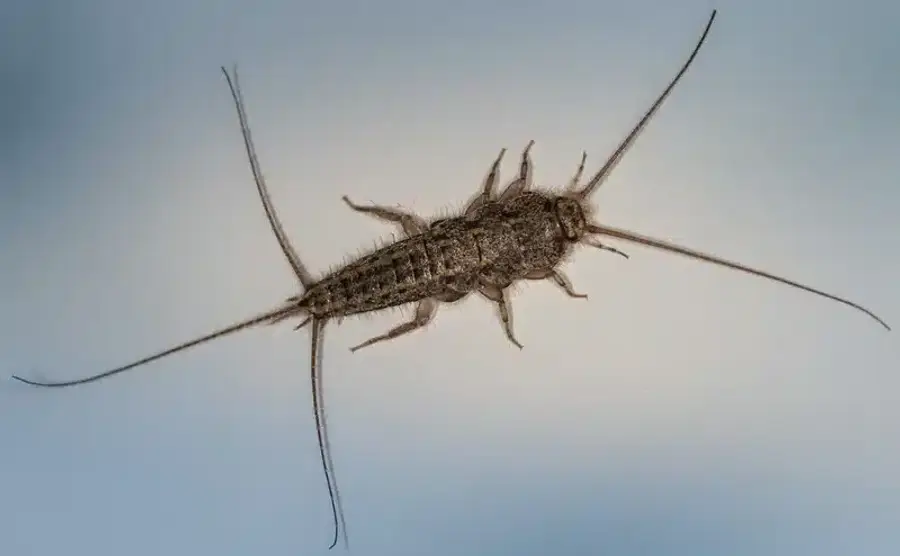
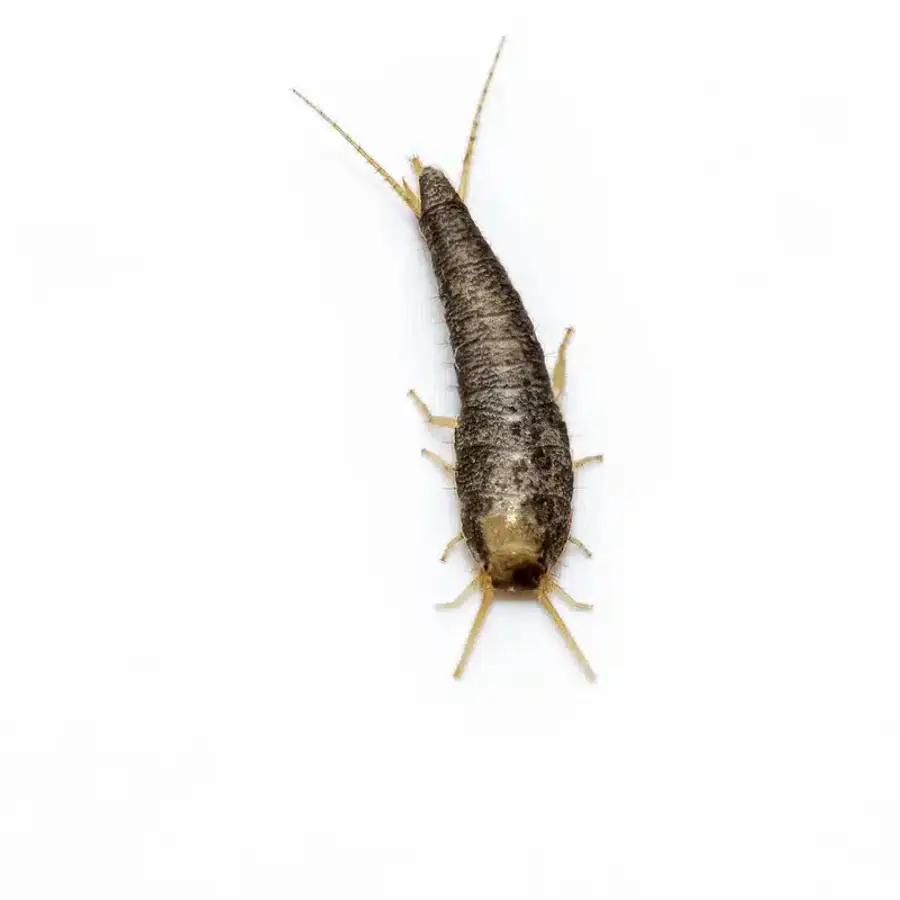
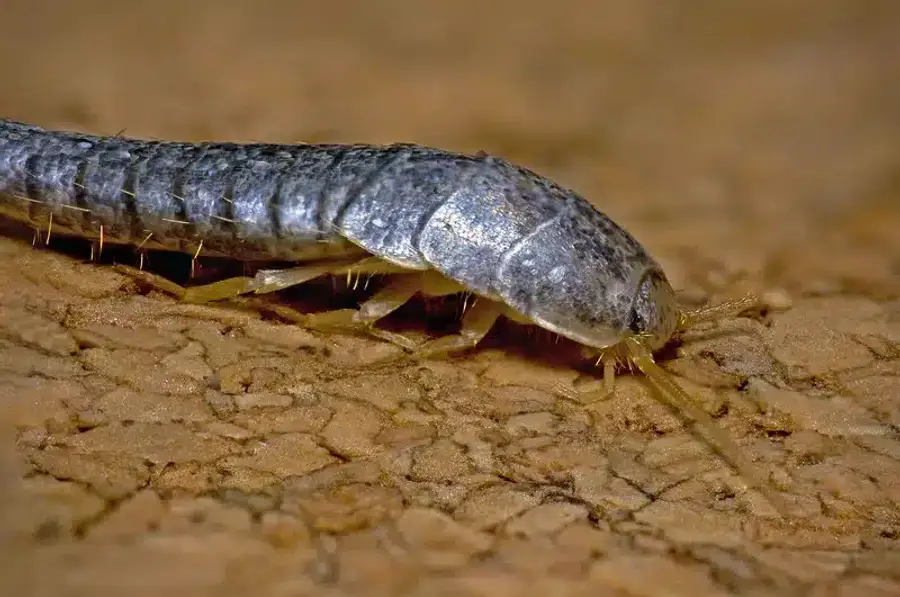
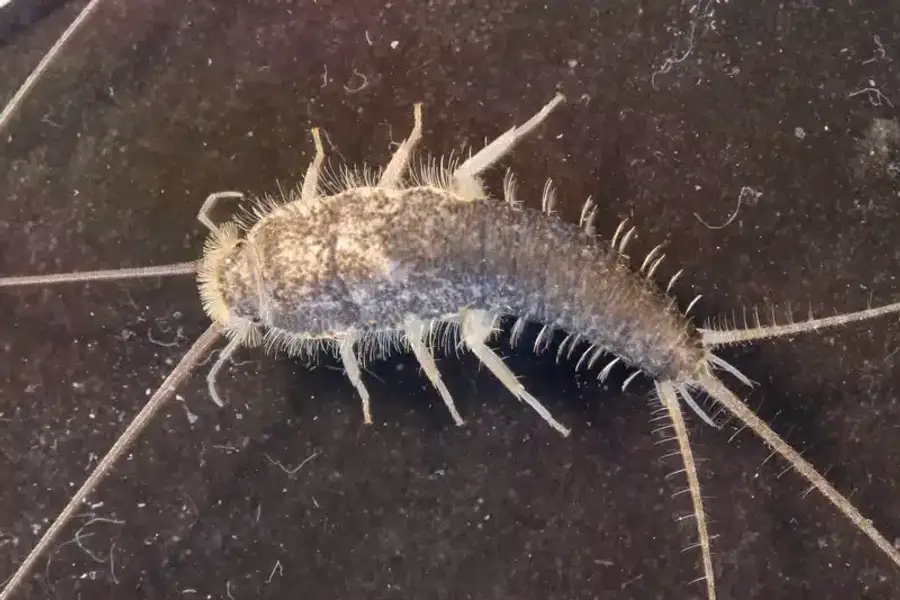

These early-stage insects also have a temporary “hatching organ” on their head that gets shed after their first molt. Additionally, their three tail-like appendages (two cerci and one central epiproct) are much shorter than you’d see on adults.
As silverfish larvae progress through later instars, their appendages lengthen and their bodies begin to darken. The distinctive silver scales don’t appear until around the fourth instar, which is why early detection focuses on finding these scale-less, cream-colored nymphs.
Many homeowners mistake these early silverfish larvae for other tiny brown bugs in bathrooms or even think they’re just moving dust particles. However, their quick, darting movements are a dead giveaway.
Silverfish Larvae Habitat and Behavior
Silverfish larvae thrive in high-humidity environments with relative humidity between 75-95%. They seek out cracks, crevices, and hidden spaces like the edges of cardboard boxes, underneath stored papers, and behind baseboards.
According to the University of Florida’s Featured Creatures database, temperature preferences vary by species. Common silverfish prefer 72-81°F, while gray silverfish can tolerate cooler temperatures between 46-77°F, and firebrats need temperatures above 90°F.
Here in the DMV area, basement humidity routinely exceeds 70% during summer months. This creates perfect conditions for silverfish egg survival and larval development. Even during winter, these pests find humid micro-pockets behind walls near plumbing or in areas with moisture problems.
The larvae feed on the same materials as adults, including starches found in paper sizing, book bindings, and wallpaper paste. They also consume proteins from pet food and fabric fibers, especially rayon and linen.
Signs of Silverfish Infestation: Identifying Silverfish Eggs and Larvae
Detecting silverfish larvae early requires knowing what to look for beyond just seeing the insects themselves. Because they’re so small and translucent, you might miss them entirely if you’re not specifically searching.
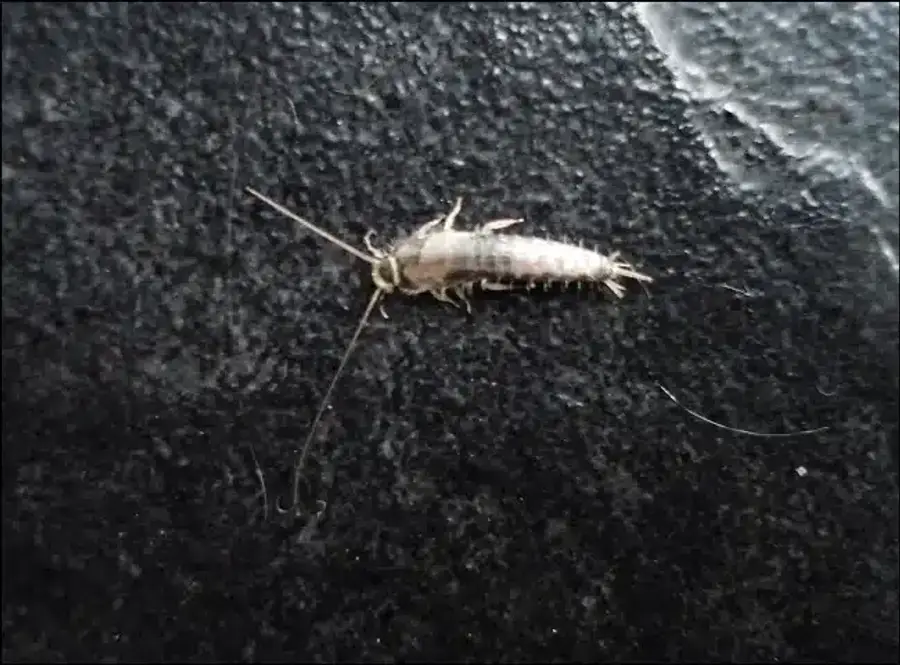
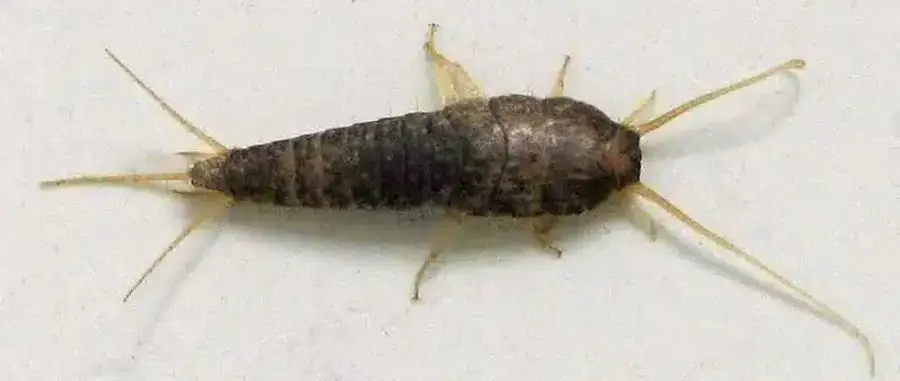

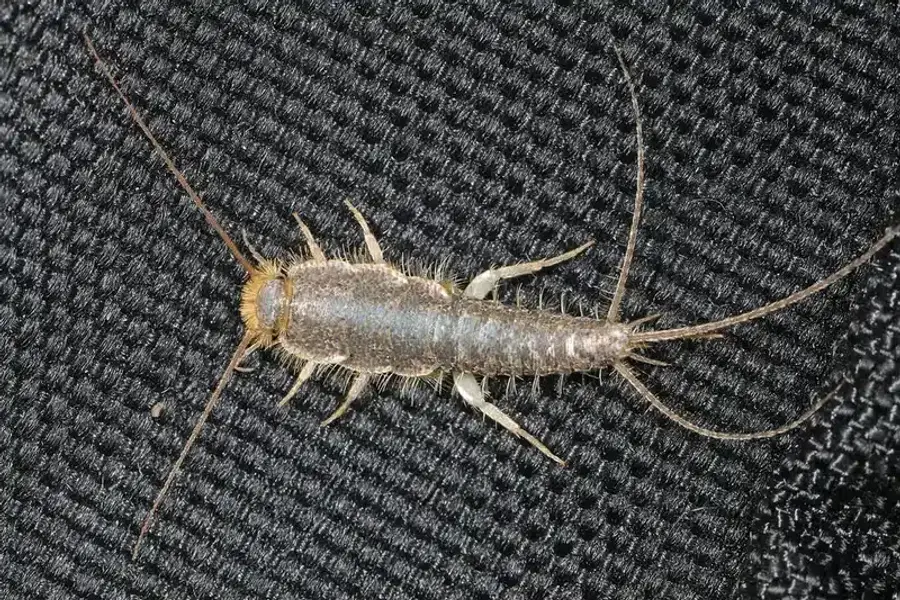
Look for tiny pepper-like black frass pellets on shelves and in storage areas. You’ll also find yellowish molt dust where larvae have shed their skins. This combination of dark droppings and pale shed skins is often visible before you spot the actual insects.
Damage signs include irregular etching marks on paper, small holes in fabric, and evidence of feeding on book bindings. The Virginia Cooperative Extension notes that this damage often appears before homeowners realize they have an infestation.
Early Detection Methods for Silverfish Larvae
Sticky traps are your best tool for monitoring silverfish larvae activity. Place them along baseboards, under sinks, inside bookcases, and in other areas where you suspect activity. Check these traps weekly, and pay attention if you’re catching more than 5 silverfish per week.
Nighttime inspections work well because silverfish are most active in darkness. Use a flashlight to check behind stored items, especially when leafing through damp cardboard or examining bathroom baseboards.
Egg clusters are harder to spot but look like crumb-like particles tucked into protected crevices. Female silverfish typically lay 2-50 eggs in batches, often in the spaces between cardboard and damp floors.
Why Early Intervention for Silverfish Larvae Matters
Catching silverfish larvae early makes control significantly easier and more effective. While they reproduce slowly, adults can live up to 8 years, creating ongoing problems if left unchecked.
Early-stage larvae are particularly vulnerable to environmental changes. Research shows that maintaining relative humidity below 55% for 2-4 weeks will kill early instars through desiccation.
I’ve seen this firsthand in older basement jobs where catching the problem in the first year allowed us to eliminate the infestation without whole-house chemical treatments. Once you’re dealing with scaled adults hiding throughout the structure, control becomes much more complex and expensive.
Silverfish Control: Non-Chemical Methods for Home Protection
Moisture Management
Reducing humidity is the most effective long-term strategy for controlling silverfish larvae. Run dehumidifiers in basements and crawl spaces, targeting relative humidity below 50%.
Fix any plumbing leaks, roof drips, or condensation problems immediately. Insulate cold-water pipes to prevent condensation, especially in humid basement environments common throughout Virginia and Maryland.
Habitat Modification and Exclusion
Remove or elevate cardboard boxes, newspapers, and fabric storage off floors and away from walls. This eliminates both food sources and egg-laying sites for adult silverfish.
Seal gaps around baseboards, utility penetrations, and window frames with caulk. This removes potential oviposition sites and makes it harder for silverfish to establish in your home.
Physical Removal Techniques
Vacuum thoroughly around cracks, shelving edges, and behind baseboards to physically remove eggs and early silverfish larvae before they develop protective scales. Focus on areas where you’ve found frass or molt dust.
For isolated infested items like books, photo boxes, or textiles, freezing at 0°F for 72 hours kills all life stages. Museums use this technique routinely for pest control in collections.
Inert Dust Treatments
Apply food-grade diatomaceous earth or silica gel lightly into wall voids and under cabinets. The University of Maryland Extension recommends these materials because they’re highly effective against freshly molted nymphs with soft cuticles.
Botanical Repellents
Japanese cedar oil sachets can provide supplemental control in archives, closets, and storage areas. While not a complete solution, they help repel silverfish larvae from sensitive materials.
Chemical Control Options for Silverfish Larvae
When non-chemical methods aren’t sufficient, targeted chemical treatments can provide additional control. Focus on crack-and-crevice applications using residual aerosols or wettable powders containing bifenthrin, deltamethrin, or cyfluthrin.
Dust formulations work well in wall voids and other hidden areas where silverfish larvae develop. Boric acid-based dusts are particularly effective when applied properly to areas insects will contact.
For heavy infestations in attics or basements, orthoboric acid baits containing 5% or less active ingredient can help reduce populations. Always follow label directions exactly and combine chemical treatments with moisture reduction and exclusion tactics.
Remember that all the products we use are EPA-approved, having passed through our internal research team. Each product is one we would feel comfortable using in our own homes.
Integrated Pest Management for Silverfish Larvae
Effective silverfish larvae control requires a systematic approach rather than relying on any single method. Start with inspection and monitoring using sticky traps and nighttime flashlight checks.
Next, address moisture sources and reduce relative humidity throughout your home. Combine this with sanitation efforts like decluttering and vacuuming eggs and nymphs from hiding areas.
Apply spot treatments with inert dusts or freeze individual infested items as needed. If monitoring traps continue capturing more than 5 silverfish per week after 4 weeks of non-chemical control, consider adding targeted chemical treatments.
Continue monitoring for a full 12 months before considering the infestation eliminated. Because silverfish development can take up to 3 years depending on conditions, patience and persistence are essential.
How Silverfish Larvae Differ from Other Pests
Silverfish larvae are often confused with other small household insects, but several key differences help with identification. Unlike centipedes or millipedes, silverfish larvae have only 6 legs and belong to the insect order rather than being arachnids or other arthropods.
Firebrats (Thermobia domestica) are closely related but prefer much higher temperatures, typically above 90°F. You’ll find these near furnaces, hot water heaters, and other heat sources rather than in cool, damp basements.
The carrot-shaped body and three-tailed appearance distinguish silverfish from earwigs, which have prominent pincers, or springtails, which are much smaller and have different movement patterns.
Understanding what attracts different pests helps with prevention. While many insects seek moisture, silverfish specifically target starchy materials and can feed on surprisingly diverse materials throughout your home.
Professional Pest Control: Expert Silverfish Home Protection
When silverfish larvae infestations persist despite your best efforts, professional intervention can provide the expertise and tools needed for complete elimination. Our registered technicians have the experience to identify all the factors contributing to silverfish problems in your specific home.
Professional treatment often involves accessing wall voids and other areas that are difficult for homeowners to treat effectively. We also have access to professional-grade monitoring tools and treatment materials that aren’t available to consumers.
Most importantly, professional pest control provides ongoing monitoring and retreatment as needed. Because silverfish can live for years and reproduce slowly over time, eliminating an established population often requires sustained effort over multiple seasons.
For homes throughout Northern Virginia, Alexandria, Bethesda, and Reston, our family business has developed specific strategies that work in our regional climate and housing types.
If you’re dealing with silverfish larvae in your home, early action makes all the difference in preventing a minor problem from becoming a major infestation. Professional assessment can help you understand exactly what you’re dealing with and develop an effective long-term control strategy.
Learn More About Silverfish: Frequently Asked Questions
What do silverfish larvae look like?
+
**Silverfish larvae** appear as tiny, cream-white, translucent insects measuring 2-3 mm long. Early instars lack the silver scales found on adults and have proportionally large heads with short antennae and tail appendages. They move quickly in darting motions and are often mistaken for moving dust particles.
How long do silverfish larvae take to mature?
+
Development time varies significantly based on temperature and humidity conditions. [The Missouri Extension reports](https://extension.missouri.edu/publications/g7376) that silverfish can take anywhere from 3 months to 3 years to reach sexual maturity. Warmer, more humid conditions speed development, while cooler, drier environments slow it considerably.
Where do silverfish larvae hide in my home?
+
**Silverfish larvae** prefer high-humidity hiding spots including cracks behind baseboards, spaces between cardboard and floors, bathroom wall voids, areas under sinks, and storage rooms with paper materials. They're particularly common in basements, crawl spaces, and upper-level bathrooms in older homes.
Can I get rid of silverfish larvae without chemicals?
+
Yes, non-chemical methods can be highly effective, especially when caught early. Key strategies include reducing humidity below 50%, vacuuming hiding areas, freezing infested items, sealing entry points, and applying food-grade diatomaceous earth. Combining multiple approaches typically provides better results than relying on any single method.
How do I prevent silverfish larvae infestations?
+
Prevention focuses on eliminating the conditions silverfish need to survive. Keep relative humidity below 50% using dehumidifiers, fix moisture problems promptly, store materials off floors and away from walls, seal cracks around baseboards and utility penetrations, and conduct regular monitoring with sticky traps in susceptible areas.
Are silverfish larvae harmful to humans?
+
**Silverfish larvae** don't bite, sting, or transmit diseases to humans. Their primary impact is property damage through feeding on starchy materials, book bindings, wallpaper paste, and certain fabrics. While they're not directly harmful to health, large infestations can cause significant damage to stored materials and household items.
What attracts silverfish larvae to my house?
+
High humidity levels, starchy food sources, and warm temperatures attract silverfish. Common attractants include cardboard storage boxes, paper materials, fabric items, pet food, and areas with moisture problems. Homes with basements, old books, stored newspapers, or humidity issues are particularly susceptible to infestation.
How can I tell if I have silverfish larvae or another pest?
+
**Silverfish larvae** have distinctive three-tailed, carrot-shaped bodies and move in quick, darting motions. Unlike other common household pests, they're translucent cream-colored in early stages and specifically target starchy materials. Look for their characteristic pepper-like frass and yellowish shed skins near feeding areas to confirm identification.
With five years of hands-on experience in the pest control industry, George Schulz is a registered technician with the Virginia Pest Management Association and a proud third-generation professional in a family business that's been protecting homes for over 57 years. He manages and trains a team of service pros while also leading internal research efforts—recently spearheading a deep-dive review of thousands of documents on pest control materials to hand-pick the most kid and pet friendly, most effective solutions tailored specifically for homes in the DC metro area.
